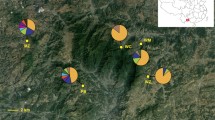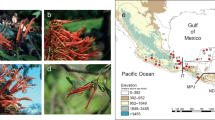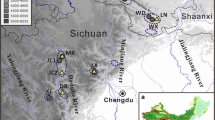Abstract
We investigated the range expansion histories of Machilus thunbergii populations in the Kinki region of central Japan on the basis of nuclear microsatellite data. In the Kinki region, M. thunbergii is typically found in the coastal area, with some fragmented populations inland, around Lake Biwa. Phylogenetic and Bayesian clustering analysis (STRUCTURE analysis) revealed that the inland populations have different genetic components between the west and east sides of Lake Biwa. The population located on the north side of the lake has an admixture of the two genetically differentiated lineages, contributing to an increase in the genetic diversity of the population. Populations around Lake Biwa had lost rare alleles and the F value obtained from STRUCTURE analysis was lower in the coastal populations than in the lake populations. These results suggest that populations around Lake Biwa experienced a bottleneck due to a founder effect during the initial migration to the lake and that glacial refugia of M. thunbergii in the Kinki region existed along the coast.






Similar content being viewed by others
References
Aoki K, Suzuki T, Hu T, Murakami N (2004) Phylogeography of the component species of broad-leaved evergreen forests in Japan, based on chloroplast DNA variation. J Plant Res 117:77–94
Aoki K, Kato M, Murakami N (2011) Phylogeography of phytophagous weevils and plant species in broadleaved evergreen forests: a congruent genetic gap between western and eastern parts of Japan. Insects 2:128–150
Austerlitz F, Jung-Muller FB, Godelle B, Gouyon PH (1997) Evolution of coalescence times, genetic diversity and structure during colonization. Theor Popul Biol 51:148–164
Comps B, Gomory D, Letouzey J, Thiebaut B, Petit RJ (2001) Diverging trends between heterozygosity and allelic richness during postglacial colonization in the European beech. Genetics 157:389–397
Cornuet JM, Luikart G (1996) Description and power analysis of two tests for detecting recent population bottlenecks from allele frequency data. Genetics 144:2001–2014
Evanno G, Regnaut S, Goudet J (2005) Detecting the number of clusters of individuals using the software STRUCTURE: a simulation study. Mol Ecol 14:2611–2620
Falush D, Stephens M, Pritchard JK (2003) Inference of population structure using multilocus genotype data: linked loci and correlated allele frequencies. Genetics 164:1567–1587
Fujii N, Tomaru N, Okuyama K, Koike T, Mikami T, Ueda K (2002) Chloroplast DNA phylogeography of Fagus crenata (Fagaceae) in Japan. Plant Syst Evol 232:21–33
Goudet J (2001) FSTAT; a program to estimate and test gene diversities and fixation indices version 2.9.3. Available at http://www.unil.ch/izea/softwares/fstat.html
Hattori T (1992) Synecological study on Persea thunbergii type forest: geographical distribution and habitat conditions of Persea thunbergii forest. Jpn J Ecol 42:215–230
Hattori T (2001) Chapter 7. Shuseibutsugaku Kenkyu 24:203–222 (in Japanese).
Hattori (2011) Environment and vegetation, 30 lectures. Asakura, Japan. pp 24-27 (in Japanese).
Hattori T, Nakanishi S (1985) On the distributional limits of the lucidophyllous forest in the Japanese Archipelago. Bot Mag Tokyo 98:317–333
Hattori T, Nakanishi S, Takeda Y (1987) The chronological study of the main lucidophyllous species in the Kinki district with special reference to their immigration during the postglacial period. Jpn J Ecol 37:1–10
Heuertz M, Hausman JF, Hardy OJ, Vendramin GG, Frascaria-Lacoste N, Vekemans X (2004) Nuclear microsatellites reveal contrasting patterns of genetic structure between western and southeastern European populations of the common ash (Fraxinus excelsior L.). Evolution 58:976–988
Hewitt GM (1996) Some genetic consequences of ice ages, and their role in divergence and speciation. Biol J Linn Soc 58:247–276
Hewitt GM (2000) The genetic legacy of the Quaternary ice ages. Nature 405:907–913
Hiraoka K, Tomaru N (2009) Genetic divergence in nuclear genomes between populations of Fagus crenata along the Japan Sea and Pacific sides of Japan. J Plant Res 122:269–282
Horikawa Y (1972) Atlas of the Japanese flora: an introduction to plant sociology of East Asia. Gakken, Tokyo
Iwasaki T, Aoki K, Seo A, Murakami N (2012) Comparative phylogeography of four component species of deciduous broad-leaved forests in Japan based on chloroplast DNA variation. J Plant Res 125:207–221
Kamei T, Research Group for the Biogeography from Wurm Glacial [please check] (1981) Fauna and flora of the Japanese islands in the last glacial time. Quant Res 20:191–205 (in Japanese)
Kaneko Y, Lian C, Watanabe S, Shimatani K, Sakio H, Noma N (2012) Development of microsatellites in Machilus thunbergii (Lauraceae), a warm temperate coastal tree species in Japan. Am J Bot 99:e265–e267
Kitamura S (1968) Phytogeography of Shiga Prefecture. In: Kitamura S (ed) Flora of Shiga Prefecture, Hoikusha (in Japanese)
Langella O (1999) Populations 1.2.30: population genetic software (individuals or populations distances, phylogenetic trees). France. Available at http://bioinformatics.org/~tryphon/populations/
Le Corre V, Kremer A (1998) Cumulative effects of founding events during colonisation on genetic diversity and differentiation in an island and stepping-stone model. J Evol Biol 11:495–512
Mantel NA (1967) The detection of disease clustering and a generalized regression approach. Cancer Res 27:209–220
Maruyama T, Fuerst PA (1985) Population bottlenecks and nonequilibrium models in population genetics. II. Number of alleles in a small population that was formed by a recent bottleneck. Genetics 111:675–689
Matsushita M, Maeda Y (1984) Chapter IV. 4. 4. Quadrangle Series 11: 85–93
Matsusue K, Fujiwara O, Sueyoshi T (2000) Climatic condition in the Last Glacial Maximum in Japan. JNC Tech Rev 6:93–104 (in Japanese)
Milligan B (1992) Pant DNA isolation. In: Hoezel AR (ed) Molecular genetic analysis: a practical approach. IRL Press, Oxford, pp 59–88
Nei M (1972) Genetic distance between populations. Am Nat 106:283–292
Nei M (1987) Molecular Evolutionary Genetics. Columbia University Press, New York
Nei M, Maruyama T, Chakraborty R (1975) The Bottleneck Effect and Genetic Variability in Populations. Evolution 29:1–10
Noda A, Mitsui Y, Ikeda H, Setoguchi H (2009) Long-term isolation of the coastal plant Calystegia soldanella (Convolvulaceae) in ancient freshwater, Lake Biwa, Japan. Biol J Linn Soc 102:51–66
Noma N, Yumoto T (1997) Fruiting phenology of animal-dispersed plants in response to winter migration of frugivores in a warm temperate forest on Yakushima Island, Japan. Ecol Res 12:119–129
Ohtsuki T, Kaneko Y, Setoguchi H (2011) Isolated history of the coastal plant Lathyrus japonicus (Leguminosae) in Lake Biwa, an ancient freshwater lake. AoB Plants. doi:10.1093/aobpla/plr021
Ooi N, Tsuji S (1989) Palynological study of the peat sediments around the Last Glacial Maximum at Hikone, the east shore of Lake Biwa, Japan. J Phytogeogr Taxon 37:37–42
Peakall R, Smouse PE (2006) GENALEX 6: genetic analysis in Excel. Population genetic software for teaching and research. Mol Ecol Notes 6:288–295
Petit RJ, Aguinagalde I, de Beaulieu JL, Bittkau C, Brewer S, Cheddadi R et al (2003) Glacial refugia: hotspots but not melting pots of genetic diversity. Science 300:1563–1565
Piry S, Luikart G, Cornuet JM (1999) BOTTLENECK: a computer program for detecting recent reductions in the effective population size using allele frequency data. J Hered 90:499–503
Pritchard JK, Stephens M, Donnelly P (2000) Inference of population structure using multilocus genotype data. Genetics 155:945–959
Pritchard JK, Wen X, Falush D (2009) Documentation for structure software: version 2.3. http://pritch.bsd.uchicago.edu/structure_software/release_versions/v232/structure_docpdf
Rousset F (1996) Equilibrium values of measures of population subdivision for stepwise mutation processes. Genetics 142:1357–1362
Sakaguchi S, Takeuchi Y, Yamasaki M, Sakurai S, Isagi Y (2011) Lineage admixture during postglacial range expansion is responsible for the increased gene diversity of Kalopanax septemlobus in a recently colonised territory. Heredity 107:338–348
Tagawa H (1973) An investigation of initial regeneration in an evergreen broadleaved forest of Minamata special research area of IBP. I. Seedling production and the distribution of two dominant species. Rep Ebino Biol Lab Kyushu Univ 1:73–80
Takahara H (1998) Vegetation history in Kinki region. In: Yasuda Y, Miyoshi N (eds) Vegetation history in the Japanese Archipelago. Asakura, Tokyo, pp 114–137 (in Japanese)
Takahashi T, Tani N, Taira H, Tsumura Y (2005) Microsatellite markers reveal high allelic variation in natural populations of Cryptomeria japonica near refugial areas of the last glacial Period. J Plant Res 118:83–90
Tsuda Y, Ide Y (2005) Wide-range analysis of genetic structure of Betula maximowicziana, a long-lived pioneer tree species and noble hardwood in the cool temperate zone of Japan. Mol Ecol 14:3929–3941
Tsukada M (1982) Cryptomeria japonica: glacial refugia and late-glacial and postglacial migration. Ecology 63:1091–1105
Tsukada M (1983) Vegetation and climate during the Last Glacial Maximum in Japan. Quat Res 19:212–235
Tsukada M (1984) A vegetation map in the Japanese archipelago approximately 20,000 years b.p. Jpn J Ecol 34:203–208 (in Japanese)
Tsumura Y, Kado T, Takahashi T, Tani N, Ujino-Ihara T, Iwata H (2007) Genome-scan to detect genetic structure and adaptive genes of natural populations of Cryptomeria japonica. Genetics 176:2393–2403
Walter R, Epperson BK (2001) Geographic pattern of genetic variation in Pinus resinosa: area of greatest diversity is not the origin of postglacial populations. Mol Ecol 10:103–111
Weir BS, Cockerham CC (1984) Estimating F-statistics for the analysis of population structure. Evolution 38:1358–1370
Widmer A, Lexer C (2001) Glacial refugia: sanctuaries for allelic richness, but not for gene diversity. Trends Ecol Evol 16:267–269
Wright S (1943) Isolation by distance. Genetics 28:114–138
Yumoto T (1987) Pollination systems in a warm temperate evergreen broad-leaved forest on Yaku Island. Ecol Res 2:133–145
Acknowledgments
We thank S. Tsukiyama and D. Kado for their help in collecting samples, and M. Yokogawa for helpful comments on data analysis. We are indebt to E. Hamabata for provision of reference documents. We also thank T. Nishida and two anonymous reviewers for helping to improve the manuscript. This research was supported by a Grant-in-Aid for Scientific Research (No. 21310152) from the Ministry of Education, Culture, Sports, Science and Technology.
Author information
Authors and Affiliations
Corresponding author
Rights and permissions
About this article
Cite this article
Watanabe, S., Kaneko, Y., Maesako, Y. et al. Range expansion and lineage admixture of the Japanese evergreen tree Machilus thunbergii in central Japan. J Plant Res 127, 709–720 (2014). https://doi.org/10.1007/s10265-014-0650-2
Received:
Accepted:
Published:
Issue Date:
DOI: https://doi.org/10.1007/s10265-014-0650-2




